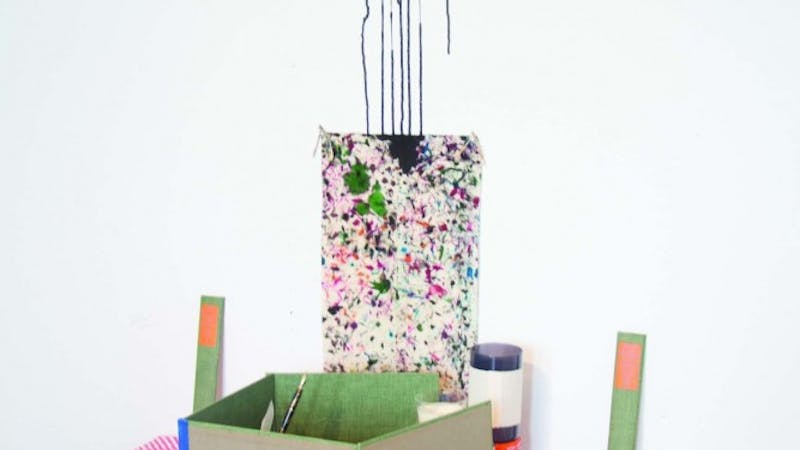
Senior studio cultivates innovation
There is no classroom on campus quite like Senior Studio. The room is divided into a maze of white walls, together forming each of the students’ studio spaces. The spaces are occupied with eclectic objects and media: photographs, couches, projections, a bicycle. Voices echo throughout the room as the senior art students and their professors discuss each project.In Senior Studio, a required class for all art majors, seniors work together, capping four years spent apart in specialized classes. Students get more freedom and more opportunities for collaboration, and their own spaces to curate as they please.Natasha Bowdoin, the professor for the course, said the course has two primary goals: first, to provide students with research practice that ultimately leads into their senior thesis exhibition, and second, to expose students to art through critical viewing and discussion.“Viewing exhibitions and listening to other artists speak about their work is a means to stimulate what happens inside the students’ own studios as well,” Bowdoin said. “[Senior Studio] is an important class because it gets closest to what it’s like to be an artist in the world making work.”Bowdoin said the class is also important because it encourages students to develop a more nuanced view of both art and life in general.“Another goal of mine ... is to help give these students, whatever their future careers, a lens through which to understand the world,” Bowdoin said. “An artistic perspective can sometimes be considered deliberately weird ... but in my opinion it can actually contribute to a clearer, deeper perception of the things and people around us.”Baker College senior Ashlyn Herd, a student currently taking the class, said Senior Studio requires students to take on a range of new responsibilities in showcasing their work.”“What is different is having so much control over our own spaces and ultimately having a show that we do all by ourselves,” Herd said. Another student in the class, Baker College senior Claire O’Malley, said her favorite part of the class is its emphasis on collaboration and the lack of highly specific requirements.“I’m going to learn a lot just by hearing people talking over their work,” O’Malley said. “It’s [also] new to have this amount of freedom.”Bowdoin said she tries to include projects throughout the course that allow students the freedom to experiment, but also provide enough guidance to generate growth.“Senior Studio in part is really about giving each student the time, space and encouragement to fully realize their own individual body of work,” Bowdoin said. “This requires time and space for a lot of student-driven activity, but I think also needs to be balanced with some prompts to help them along the way.”The class’s first assignment required the students to curate a studio space using found objects. Students interpreted the task in a variety of ways. Herd, for example, located pillows and cushions she felt a strong personal attachment toward and arranged them into a giant, three-dimensional quilt that she displayed on the wall. She said her focus is exploring new concepts, in terms of both medium and subject.“I want to develop myself in ways that I am less comfortable with,” Herd said. “The piece I did today plays with the idea of 2-D and 3-D and something that is familiar. The couch cushions are personal to me and unfamiliar to anyone else who looked at them.”O’Malley took a different route: She took pictures of spaces like the freezer and the medicine cabinet of the house she moved into this year, and blew them up into giant prints that she assembled on the walls of her space. The pictures show the spaces as they were when O’Malley first moved in, full of miscellaneous items the former tenants left behind, with the addition of small army men O’Malley arranged around them. She said she intended to explore the ways people live their lives within their constrained spaces.These senior students will continue to work throughout the year in preparation for their end of the year show in the spring, which will be open to all students and faculty.
